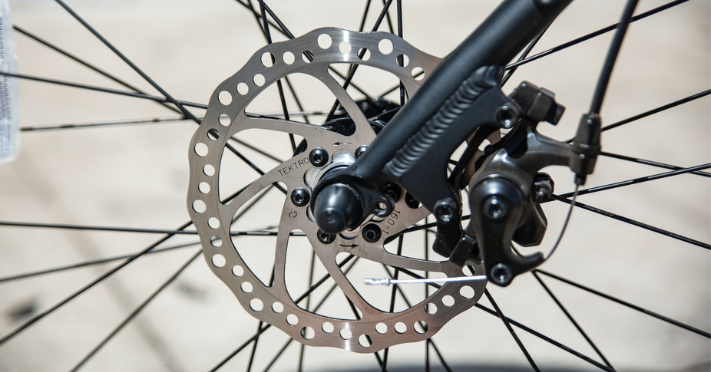One of the most cringe-worthy sounds in the world is when your tranquil ride is rudely interrupted by the screech of brake squeal! If you’re a passionate rider, this all-too-familiar annoyance has probably left you curious about the reasons behind it, but more importantly, you want to know how to put a muzzle on it.
In this guide, we’re taking a deep look into e-bike brake squeal. We’ll uncover its root causes, reveal some effective preventive measures, and provide solutions to end those aggravating squeals that disrupt your riding zen.
Understanding Brake Squeal
Brake Squeal Causes
Let’s begin by peeling back the layers of this auditory annoyance. Brake squeal in e-bikes can be attributed to various factors, but brake pad contamination is a common culprit. Think of your brake pads as sponges; they can absorb oils and contaminants, leading to that dreaded screech when applied.
A simple way to avoid this is to remove the pads before any brake maintenance involving fluids and be mindful of oily hands when handling your e-bike’s rotor. Also, using a drip-on-style lube that won’t leave your rotor greasy can help prevent contamination. If your rotor does get contaminated, clean it thoroughly with isopropyl alcohol and a clean rag.
Aside from simple contamination, there are many other reasons for brake noise, such as:
- Bent Rotors: A bent rotor can result from trail mishaps or even tolerance issues with brand-new rotors. If your rotor isn’t straight, it can lead to pinging noises as the wheel rotates. Luckily, it is possible to salvage slightly bent rotors using a rotor-truing fork, but if your rotor is seriously damaged, it’s always safer to replace it. Riding with a cracked or over-trued rotor can spell trouble for your brake pads and calipers, not to mention your own safety.
- Sticky Caliper Pistons: Sticky caliper piston seals can also contribute to brake noise. These seals prevent the piston from retracting fully, causing the brake pad to remain too close to the rotor. This not only generates noise but also results in excessive wheel drag. Replacing piston seals can be tricky, so it’s best left to trained mechanics. Keep in mind that they may require attention after several brake pad replacements.
- Bolt Torque and Spoke Tension: Sometimes, brake noise is a symptom of other related issues. Loose parts, such as caliper and rotor-mounting bolts or improperly tensioned spokes, can create vibrations that manifest as brake noise. Regularly checking and tightening these components can go a long way in preventing unnecessary issues, not just squealing.
- Improperly Aligned Disc Brake Mounts: Improperly aligned disc brake mounts can be a rider’s nightmare. Even seasoned mechanics struggle to align the caliper when the frame isn’t up to spec. If your bike hasn’t had the benefit of facing its disc tabs, strongly consider having this done by your local bike shop.
- Worn-Out Brake Pads: Worn-out brake pads are another leading and common cause of brake noise. Pads should be inspected monthly, measuring their width, including the backing plate. If it’s less than three millimeters, it’s time for a replacement. Riding with worn-out pads can not only result in noise but also cause irreversible damage to the caliper and rotor.
- Proper Pad and Rotor Break-In: Before embarking on epic rides, don’t forget to break in your brake pads and rotors. This crucial step involves applying consistent, gentle pressure on the brakes for a few minutes on a flat or gradual downhill grade. This technique ensures that a small amount of pad material is transferred into the rotor’s microscopic pores, enhancing performance and reducing noise.
- Temporary Squeals After Wet Adventures: Now, if you’ve recently conquered a stream crossing or cruising around in heavy rain, and your brakes start to howl, don’t cry about it! This is usually a temporary issue. Once your brakes heat up again, the problem often vanishes on its own.
- Motorcycle Sounds: If it sounds like baseball cards are stuck in your spokes, it’s probably not a brake issue. Check your chainstay for rogue zip ties that may be clinging to your rotor.
Preventing Brake Squeal
Now that we’ve dissected the leading causes of brake squeal, let’s shift gears and explore how to prevent brake squeal from rearing its noisy head in the first place.
Regular Maintenance
Importance of Regular Checkups
Regular maintenance is the cornerstone of brake squeal prevention. Like you wouldn’t skip a doctor’s checkup, don’t neglect your e-bike’s brake health. Regular inspections can catch issues before they escalate into bigger problems. Make it a habit to check your brakes monthly, paying close attention to pad wear, rotor condition, and bolt torque.
Maintenance Schedule
Establishing a maintenance schedule is essential. Consider marking your calendar for routine brake checkups. These schedules can vary depending on your riding frequency and conditions, but a general rule of thumb is a monthly inspection with more comprehensive checks every three to six months.
Proper Installation
Another critical aspect of preventing brake squeal is proper installation. Ensure that your brakes are installed correctly, as improper installation can lead to noise issues. If you’re unsure, consult a professional or seek guidance from your bike manufacturer.
Selection of Correct Brake Pads
Selecting the right brake pads is pivotal in reducing noise. Research your options and choose pads that align with your riding style, your e-bike’s overall weight, and the terrain and environment you usually ride in.
There are four main compounds used in e-bike brake pads:
- Organic: Organic compounds are the tried-and-true classics in the brake pad realm. They offer a smooth, laid-back braking experience. But be ready to replace them every few months.
- Semi-Metallic Blends: Semi-metallic compounds, as their name suggests, are a middle-ground option, providing a touch more firmness. However, they also have a somewhat shorter lifespan.
- Metallic (Sintered Pads): Metallic compounds, also known as sintered pads, are the heavy hitters in the brake pad lineup. Crafted from durable aluminum oxide, they’re built for the long haul. Yet, their unyielding nature can deliver a more assertive and abrupt braking experience.
- Ceramic (Ceramic-Metallic): Ceramic compounds, or the ceramic marvels, emerge as the heroes of brake pads. Comprising ceramic and aluminum oxide, they tend to last quite a long time. Another great thing about these is that they’re asbestos-free!
Types of E-Bike Braking Systems
Before you start going wild all over the internet looking for replacement brake pads, it’s essential to know what kind of braking system your e-bike is using.
There are two primary types of brakes for e-bikes: rim brakes and disc brakes.
- Disc brakes offer superior braking power, thanks to their design, with the braking surface situated closer to the brake pad, providing increased leverage. Disc brakes perform well in wet conditions, making them the preferred and reliable choice for e-bike riders.
- Rim brakes are less common for e-bikes due to their relatively weaker performance and ineffectiveness in wet conditions, and work by compressing brake pads against the wheel rim.
E-bikes are notably heavier than traditional bikes due to their reinforced frames, motors, batteries, and electrical components. This added weight and the fact that e-bike riders often carry more cargo and ride faster, which places more demand on the braking system.
Over-The-Counter Products
In your quest to hush those noisy brakes, you may encounter a variety of over-the-counter products designed to tackle brake squeal. But, we’ll give it to you straight: most of these products are not long-term solutions or very effective.
The best way to deal with the noise is proper installation, preventative maintenance, regular inspections, and keeping your brake components as clean as possible.
Although, if you find yourself constantly battling brake noise, consider upgrading to larger rotors. While this may add a bit of weight to your e-bike, it may offer benefits such as better heat dissipation, increased braking power, and reduced noise.
Consult your local bike shop to see if your e-bike could accommodate a larger-diameter rotor.
Final Thoughts
Brake squeal might be an all-too-common nuisance for e-bike riders, but it doesn’t have to be a permanent fixture of your rides. By understanding its causes and implementing preventive measures and solutions, you can bid farewell to those ear-piercing screeches.
Remember, regular maintenance is your ally, and selecting the right brake pads can make all the difference. So, embark on your next adventure, minus the annoying brake squeal!



